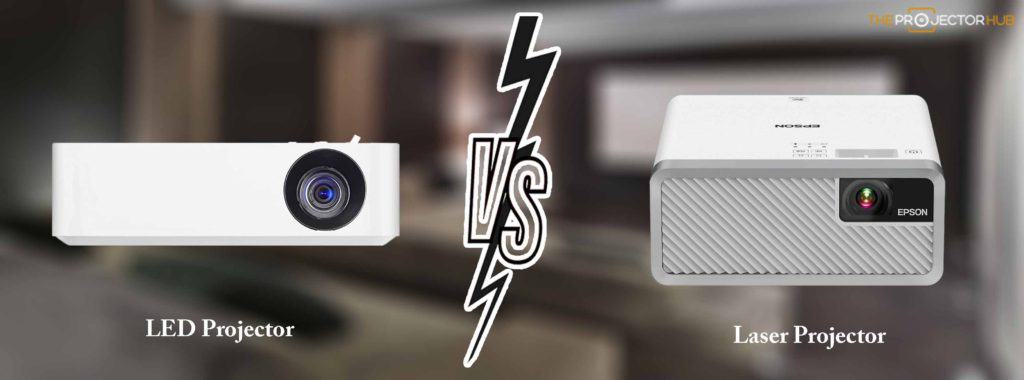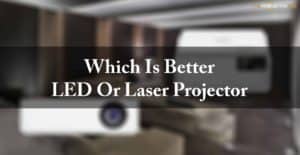 Projectors come in all shapes and sizes, with each type having its own unique benefits and drawbacks. There are many choices to make when selecting a projector. One of the most important decisions is choosing an LED or laser projector.
Projectors come in all shapes and sizes, with each type having its own unique benefits and drawbacks. There are many choices to make when selecting a projector. One of the most important decisions is choosing an LED or laser projector.
So it can be hard to decide which is better LED or Laser projector for you. We will help you compare LED and laser projectors and determine the best option for your needs.
Which Is Better LED Or Laser Projector? Detailed Guideline
Benefits of LED vs Laser Projection
A major benefit of laser and LED projection is that neither bulb contains any mercury, whereas lamp projectors have lightbulbs with a short life span. All projectors also use RGB lighting. Most other projectors also have a preference for LED lighting, while laser lighting should be used for specific other presentation types. also keep in mind that laser projectors offer higher brightness while reducing ambient light.
What is a Laser projector?
A laser projector is a digital projection system that uses a laser to create an image. This type of projector is typically used for large-scale projections, such as those seen in movie theaters or auditoriums. Laser projectors are known to have impeccable color accuracy – which is why they are used in places such as movie theaters. Most laser projectors make use of colored lases as their original source of light, which enables DLP projectors to be more accurate with their colors with higher levels of lumen.
What is a LED projector?
An LED projector is a video projector that uses light-emitting diodes (LEDs) to produce images. Light emitting diodes are small light sources that glow when current is passed through it. LED have been used commonly in the past for things such as indicator or alert lights. While the first LEDs were limited to the color red, they developed over time in both flexibility and power to produce more colors and high light intensities.
LED projectors can display high-definition images and videos and are also more energy-efficient than traditional projectors. Most TVs today use LED technology on liquid crystal displays. LED projectors make use of separate lights instead of color filters for the primary RGB colors to create images. These projectors actually directly produce the main three primary colors RGB. This allows the projectors to provide a wider color palette with more vivid and natural colors.
What to look for when choosing a good projector?
There are a few things you should look for when choosing a projector.
Life Span
It depends on how you plan to use your projector. If you only occasionally use your projector, then any of the different types will last a long time. However, if you use your projector all the time, you’ll want to focus on laser projectors. These devices are designed for constant use and, as such, have the longest stated life spans.
More specifically, if you use your projector for more than 5 hours a day, you’ll want to use a laser projector. An LED, or lamp projector will likely suffice if you use your projector for less than that. The lifespan of an LED and laser projector is claimed to have 10,000, 20,000, and 30,000 hours of use.
Cost
The cost of each type of projector is an important factor to consider.
LED projectors are generally more affordable than laser projectors. However, the total cost of ownership (TCO) for a LED projector is higher than for a laser projector. This is because LED projectors have a higher potential for replacements and repairs.
Laser projectors are more expensive than LED ones but have a lower TCO. This is because laser projectors have a longer lifespan and require less maintenance than LED projectors.
So, which type of projector is the better value for your money? It depends on your needs and budget. If you want the lowest possible TCO, then a laser projector is better. However, an LED projector may be the better choice if you are on a tight budget.
Power-up times
The power-up time of a projector is the time it takes for the device to be able to display an image after being turned on. This is an important spec for those who need to use the projector regularly, as it gives you an idea of how long you’ll need to wait before starting your presentation.
As we’ve already established, lamp-based projectors have a warm-up time that can take up to one minute. This is because the bulb needs to reach its optimal operating temperature before producing a stable image.
Laser and LED projectors, on the other hand, don’t have this issue as they don’t use a bulb. This means they can power up and be ready to use in seconds. This can be a huge time-saver for those who need to use their projector regularly.
Color Performance
Many people overlook color performance when choosing a projector as a key metric. However, if you plan on using your projector for professional presentations or home entertainment, it is important to pay attention to a projector’s color performance. After all, you want your visuals to look as accurate and realistic as possible.
There are three main types of projector technology on the market today: LED, laser, and lamp. All three technologies use the same color standard, Rec. 709. However, LED projectors offer a wider color gamut and higher color saturation than their laser and lamp counterparts.
What is Color Gamut?
Color gamut refers to the range of colors represented by a given system. The human eye can perceive a wide range of colors, but not all colors can be accurately represented by every display technology.
For example, the sRGB color gamut is the standard color space for consumer-level displays. It can represent a wider range of colors than the Rec. 709 color gamut, which is the standard for HDTVs. However, neither of these color spaces can represent the full range of colors the human eye can see.
What is Color Saturation?
Color saturation refers to the intensity of the colors within a given color space. A display with high color saturation will have more intense colors, while a display with low color saturation will have muted colors.
LED projectors offer a wider color gamut and higher color saturation than their laser and lamp counterparts. This means they can display a wider range of colors with greater accuracy and realism.
Lumens
Lumens are measurement unit that indicates a light source’s brightness. More lumens usually mean a brighter light.
LED and laser projector brightness is typically measured in ANSI lumens. This standardized way of measuring brightness allows for easy comparison between different types and brands of the projector.
Generally, LED projectors have a lower lumen count than laser projectors. However, LED projectors make up for this with improved color saturation and luminous efficiency, making them appear to have higher image quality than they actually possess.
Laser projectors typically have a higher lumen count than LED projectors, which means they can produce a brighter image. However, laser projectors can be more expensive than LED projectors.
When choosing one, you should consider what you plan to use as a projector. For example, if you use the projector in a dark room, you may not need as many lumens as you would if you were using the projector in a brightly lit room.
It is also important to consider the type of image you want to project. If you are looking for a bright, vibrant image, you will need a projector with a higher lumen count. If you are looking for a more subtle image, you may be able to get away with a projector with a lower lumen count.
In general, LED and laser projectors are good choices for projecting images. It will depend on your specific needs and preferences for which option is most suitable.
Rainbow Effect
The rainbow effect can be defined as an instance where colors are projected that do not belong in the image. This is usually caused by a color wheel not spinning fast enough. When this happens, the colors are mixed together and projected onto the screen, which can be annoying or even debilitating, depending on the intensity of the colors.
Laser and LED projectors are both susceptible to the rainbow effect. This is because they both use color wheels to generate projected colors. If the color wheel is not spinning fast enough, the colors will be mixed together, and the rainbow effect will occur.
However, there is a way to avoid the rainbow effect with LED projectors. This is because they have the option of using two-color wheels. The rainbow effect can be filtered out before it is projected onto the screen. This is not an option with laser or lamp projectors, as they only have one color wheel.
LED projector: Pros and Cons
LED projector Pros
- Wider color gamut
- Higher color saturation
- Improved color saturation and luminous efficiency
- LEDs don’t need to warm up when turned on nor do they need to cool down when turned off
- LEDs are greener because they require less energy to operate
- They require less maintenance
- LEDs don’t need loud fans and therefore are quieter
- Are typically smaller since the fans don’t take up a bunch of space
LED projector Cons
- Low Lumen
Laser projector: Pros and Cons
Laser projector Pros
- Higher lumen count
- Bright image
- Long lamp life
- Best for Gaming
- Rely on separate RGB lasers (Red, Green, Blue)
- Doesn’t require constant change of filters, meaning that maintenance drops to nearly zero
- Use very little electricity
- Have wide viewing angles and thus can be placed almost anywhere
Laser projector Cons
- More expensive than LED projectors
- Larger and heavier than their LED counterparts
Conclusion paragraph: Which is better, led or laser projector?
In general, LED and laser projectors are good choices for projecting images. In the end, your preference and needs will determine what the best option for you is. An LED projector is probably your best bet if you need a projector for home entertainment purposes. They are typically cheaper than laser projectors and offer great picture quality.
However, if you need a projector for business or professional presentations, a laser projector is likely a better choice – they tend to be more powerful and have longer lifespans.
Ultimately, it comes down to personal preference and what you will often use the projector for. Hopefully, after reading this article, you can decide which projector type suits your needs better.
